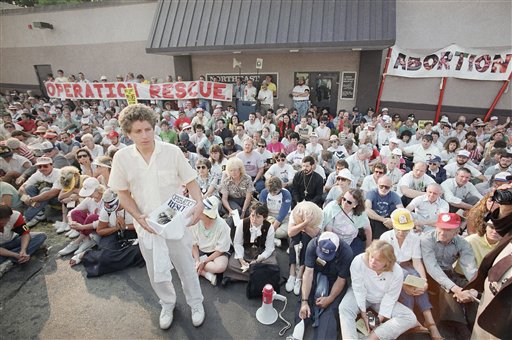In Bray v. Alexandria Women’s Health Clinic, 506 U.S. 263 (1993), the Supreme Court ruled that abortion protesters’ actions did not constitute a conspiracy against a protected class and therefore did not violate the Civil Rights Act of 1871. Although Bray is generally considered an abortion/women’s rights case, it sits at the intersection of the First Amendment rights of political assembly and protest and the right to obtain an abortion under Roe v. Wade (1973).
Women’s health clinic obtained an injunction to stop anti-abortion demonstration
In the late 1980s, anti-abortion groups such as Operation Rescue staged demonstrations in which protestors attempted to block the entrances of clinics providing abortions and verbally or physically confronted people entering them. Between 1987 and 1990, more than 400 such blockades occurred and thousands of protesters were arrested. Many demonstrations turned violent. During this period, several clinics were bombed and some clinic staff members were assaulted and even murdered.
In 1989, Operation Rescue announced that it would target the Women’s Health Clinic in Alexandria, Virginia. Fearing disruption of business and possible violence, the clinic attempted to stop the protest by obtaining an injunction from a federal court under section 1985(3) of the Civil Rights Act of 1871.
1871 law prohibited conspiracy to deny equal protection under the law
The law, often referred to as the “Ku Klux Klan Act,” was passed after the Civil War to protect newly freed slaves from intimidation. Among its provisions, the act bars conspiracy on the part of private actors to deny “any person or class of persons the equal protection of the laws.”
The district court ruled that under section 1985(3), the actions of Operation Rescue comprised a conspiracy to deprive women of their right to obtain an abortion. The 4th U.S. Circuit Court of Appeals affirmed the district court.
Court reversed injunction and said the protests did not target a protected class of people
On appeal, the Supreme Court reversed the lower courts. Relying on the reasoning in Geduldig v. Aiello (1974), Justice Antonin Scalia held that although sex is a legally protected class, the proper classification in this case was not sex but pregnancy. While all pregnant people were women, not all women were pregnant.
Moreover, in Griffin v. Breckinridge (1971) the Court found that under section 1985(3), a hostile intent toward the protected class must be shown; in this case, the hostility shown was not toward women but toward abortion. Therefore, the law did not apply, and the injunction had been improperly granted. Scalia noted that existing state laws were sufficient to cover any illegal conduct that might occur.
Justices John Paul Stevens and Sandra Day O’Connor dissented. Stevens argued that an interstate conspiracy to violate rights existed and was therefore a federal issue. O’Connor, rejecting Geduldig, argued that women were indeed the class in question.
Case raised First Amendment question on right of protest
Even though the law under review in this case does not specifically deal with free speech and the Court’s opinions do not directly address it, Bray raises a significant First Amendment question concerning limits on the right of protest.
A ruling favoring the clinic might have brought into question the rights of individuals to gather and cross state lines to conduct political protest. The Court’s decision thus strengthens First Amendment rights to political speech.
This article was originally published in 2009. Stephen Robertson is an Adjunct Assistant Professor of Political Science and International Relations at Middle Tennessee State University, where he has taught for about 25 years. He has always had a deep interest in constitutional law and the First Amendment and explores these topics in his courses on American government and women’s rights under American law.

